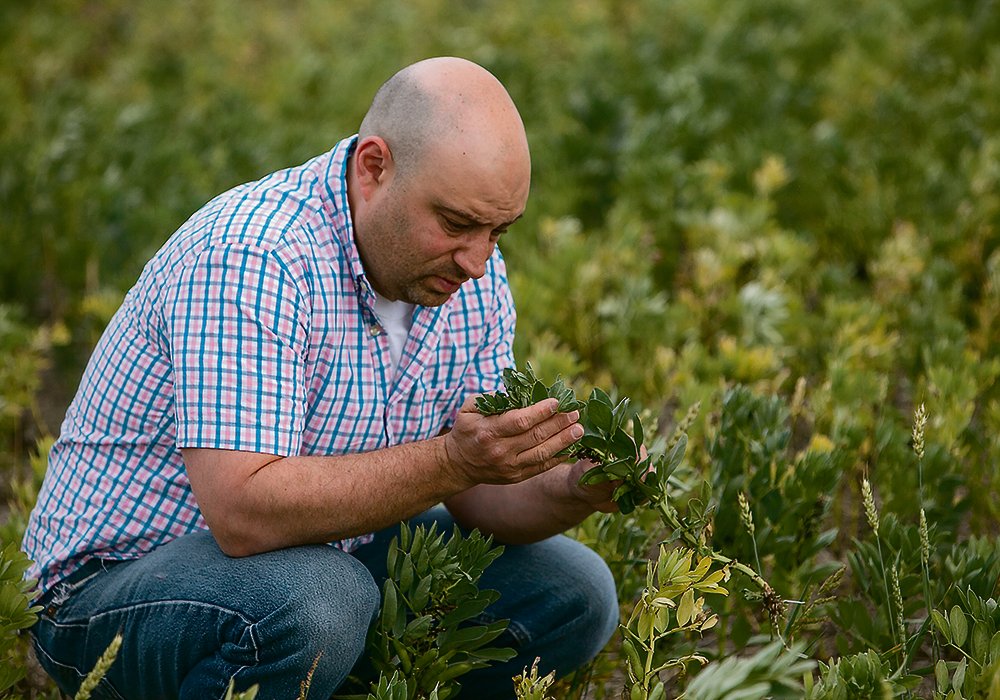University puts bugs in its crosshairs

New insect research facility at the U of S will help researchers create knowledge to help manage rural and urban lands
For years, insect expertise was rare at the University of Saskatchewan, a noticeable omission in an institution with a large agricultural mandate.
“It was something that was increasingly identified as a need,” said U of S entomologist Sean Prager. “In the past people didn’t necessarily worry about insects as much in agriculture here.”
Prager, who joined the U of S in 2017 from the University of California, Riverside, is in charge of a new $1 million insect research facility that will be devoted to studying the complex beneficial and destructive roles insects play in Canadian fields. This includes high profile pests, as well as emerging threats such as lygus bugs in canola and fababeans.
“We do have a little bit of work with wheat midge along with Ag Canada, but we’re more in cloverleaf weevils, which is big problem for forage seed growers,” he said. “We’ve been doing a lot on aster leaf hoppers, a lot of work with pea aphid, which has become more of a problem.”
USIRF (U of S insect research facility) will be built on the sixth floor of the College of Agriculture and Bioresources in Saskatoon. Construction is slated to start late this year, with completion planned for next year.
Canadian Food Inspection Agency certification is a wild card in terms of timing, but Prager hopes to have the facility up and running by summer or fall of 2022.
He and his team also work on insect-borne diseases, another area of research that is rare on the Prairies.
“We also do a lot of work with vector pathogens,” Prager said. “We’re often working with plant viruses… we’re probably the only people in the area, maybe the only people in Western Canada that really specialize in that kind of stuff.”
This last has an example close to home for city dwellers on the Prairies, who saw thousands of black ash trees drop their leaves and die due to a deadly pathogen spread by the cottony ash psyllid, an invasive insect.
“We’ve now determined that probably the reason that all the ash trees in Saskatoon and Regina and all the ones that have to get chopped down, that are sick, we found out it’s a pathogen,” Prager said. “We’re fairly certain now, it’s a pathogen transmitted by the insects that are attacking those trees.”
Prager said the pathogen, a bacterium, is closely related to the one spread by the Asian citrus psyllid that causes the citrus greening disease currently threatening an entire fruit industry in Florida and Texas.
Another closely related pathogen causes zebra chip disease in potatoes. Spread by the potato psyllid, it was first spotted in Western Canada by researchers at the University of Lethbridge in Alberta.
USIRF represents a significant addition to research capacity into insect research, something the U of S has made a priority in the past few years, said Prager, whose mandate includes beneficial species and the habitats they need to thrive.
“We have a very large project where we’re looking to characterize the pollinator communities across different crop types to see what the effects of, say, wetland margins are,” he said.
Wild pollinators include bees, flies, butterflies and moths and their effect can be profound. While Prager said it’s hard to get a precise number, insect-boosted pollination in canola can mean a 30 to 60 percent yield advantage.
“So if you have a canola field and a prairie pothole in it, would you be better off plowing the prairie pothole as people usually do?” he said. “Or would you actually be better off leaving it or even making it larger because you’ll get more bees and therefore more yield?”
Pollinators are also important for forage crops, such as clover, sanfoin and alfalfa. While the latter are served by domesticated leafcutter bees, Prager said the other forages do better with healthy populations of wild pollinators.
USIRF will allow Prager and his 10-person team to build on their foundation of “good old-fashioned entomology,” that is, research in the field. According to a U of S media release, it is the first facility of its kind at a western Canadian university and one of only a handful in the country.
To non-entomologists, Prager said it won’t look that remarkable: it will be mostly a giant room, with facilities to create controlled environments for insects. This means walk-in environment rooms, environment chambers and standard lab equipment.
The most important features will be hidden. Special air handling and filtering will ensure negative pressure in the labs, so air flows in when a door is opened and no insects or pathogens escape.
Water drains are also fitted with filters, and lighting is designed so it doesn’t lure insects out of their chambers.
There will also be procedures for researchers entering and leaving the facility.
“There’s an anteroom, so you can’t just go straight in,” Prager said, adding users will need to put on special suits. “There’s a room where you can change and make sure you don’t have any hitchhikers on you.”
The ability to isolate insects will make it possible for Prager and his team to get the jump on emerging pests. For example, while the potato psyllid and zebra chip disease haven’t become a problem yet for Alberta potato growers, it’s plaguing farmers across the border in Idaho, Washington and, occasionally, North Dakota.
“This is exactly the sort of problem we could use the facility to do the research on,” Prager said. “You can’t currently keep those (potato psyllids), because we don’t officially have them here.”
Source: www.producer.com

